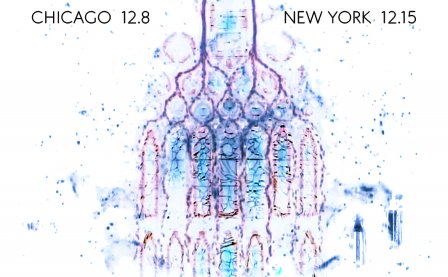Cinterland is a new collaborative record from experimental duo High Plains, consisting of Wisconsinite cellist Mark Bridges and Vancouver-based electronic composer Scott Morgan, known best as Loscil. It plays at an unfurling horizon, recognizably historicized in time and space by the rural gothic themes it reviews: expansion, the 1850s, The West. This suture in spacetime has reemerged with renewed currency in the contemporary psyche through the televisual genre of rural crime: most notably the first season of True Detective, but also threading through archetypically Western serials Westworld and Deadwood, as well as art-minded blockbuster films such as There Will Be Blood, No Country For Old Men, and The Witch. In a gesture parallel to our increasingly complex and partisan reality, we consume these perversely comforting meditations on violence with reverent focus: perverse because it relies on an almost fetishistic, occult veneration for the brutality and psychotic violence of the frontiers, but comforting for that same reason. It simplifies and codifies that which is inherently horrifying with Manichean oppositions.
Recorded “on location” in rural Montana, Cinderland shares with these filmic sutras a devotional attention to the volatility latent in silence and isolation. Its bare compositional threads — austere, droning synth work and Steinway piano building a bleak and tentative conveyance of suspended motion highlighting Bridges’s cello runs, tense with unyielding dread and the sinew of toil — form a kind of elemental language unto itself that navigates the conjured landscape with equal parts deliberation, revulsion, and hysterical fervor.
In And: A Phenomenology of the End, Franco “Bifo” Berardi outlines several possible aesthetic (and therefore perspectival) means of relating to the historical rapid expansion of psychic and geographic territory. Baroque aesthetics reacted to the sprawling proliferation of non-collapsible perspectives based on the expansion of geographical and logical territories, accumulating in an awed, fractured, and ornamented reverence for the God’s infinitudinal spirit. The Protestant imaginary, which found its ultimate form in the repressed and genocidal spirit of the American Puritan, hinged instead on a fascistic collapse of perspective and subsequent bifurcation of the world into good and evil components justifying necessary exercises of power and violence.
The type of Western-gothic neoclassical score employed in the rural crime psychodrama, which mildly subverts classic Americana themes with avant-jumpscare moments of choral dissonance, constitutes an antagonistic reaction to the same complexity that the Baroque adores: a tactical, technologized, and ironic review of the populist regression into fantasies of bluntly demarcated universes necessitating discretely mandated action into good and evil components, what eventually amounts to an apocalyptic fantasy latent in the untenable indecipherability and deterritorialization of the present.
The bleak suites on Cinderland play like the scores to an unmade rural violence drama, but one where there are no human roles to play, only roiling landscapes of blood and rock. They disclose a projected landscape whose very expanse is claustrophobic, its endlessness breeding panic and hypoxia, making conspicuous the absence of that perversely comforting and artisanal voiceover alcoholically waxing about the space-time continuum and the base drives of the human animal.
Indeed, Cinderland’s titular theme could confidently track the opening sequence to a lost True Detective universe located at the eerie, hollow core between the two season’s opposing coastal locales. In the televisual examples listed above, a cult of violence and hysteria problematize the historical violence that’s absent from the “blank-canvas” false premise of the Western frontier: in a sublime filmic absolution, the acute psychodramas in these shows betray the latent imprint of genocides and oppressions that were wholly systematic, formative lies contradicting the neo-human project of the American Puritan that still scaffolds the national psyche.
Second track “Blood that Ran the Rapids” — a swelling, hydraulic dirge wrapped around a lone tonal synth snare that sounds like the homicidal technology of skin stretched over a drum — directly calls to mind this absent trauma. Expertly cultivating a structure of psychological horror, “The Dusk Pines” briefly withdraws from the precipice of terror and operates on a more open and ambivalent plane, only to plunge hysterically into bloodlust with the seething stomach-drop at the midpoint of “A White Truck,” and then abate again with the precarious thrum of “Ten Sleep.” The record’s second half is sedate by comparison, skewing away from the drone element and more toward conventional pastoral film score calling to mind Terrence Malick.
It is in this tension between unstable generic conventions and the wholesale absorption of the avant-garde by the filmic mainstream that Cinderland coheres to comment on differing aesthetic-perspectival means of processing the deterritorializing gesture belying the expansion of territory. Just as the archaic pastoral of hysterical frontier violence serves to make visible a flimsy pathology located at a present-day impasse, High Plains turn the inner gaze to the collapse of the ego at the borders of the modern-day town, an anxiety over the thorough deterritorialization of geographic and spatial identity by the unstoppable churn of global semiotic capitalism. As the technological, schizophrenic Baroque and the puritanical Protestant spirit mutually recombine within its fathomless, self-cannibalizing expanse, the neoclassical problematic posed by High Plains yearns to cohere into a neo-subjectivity that does not psychotically fantasize itself out of existence.
More about: High Plains, Loscil, Mark Bridges, Scott Morgan




